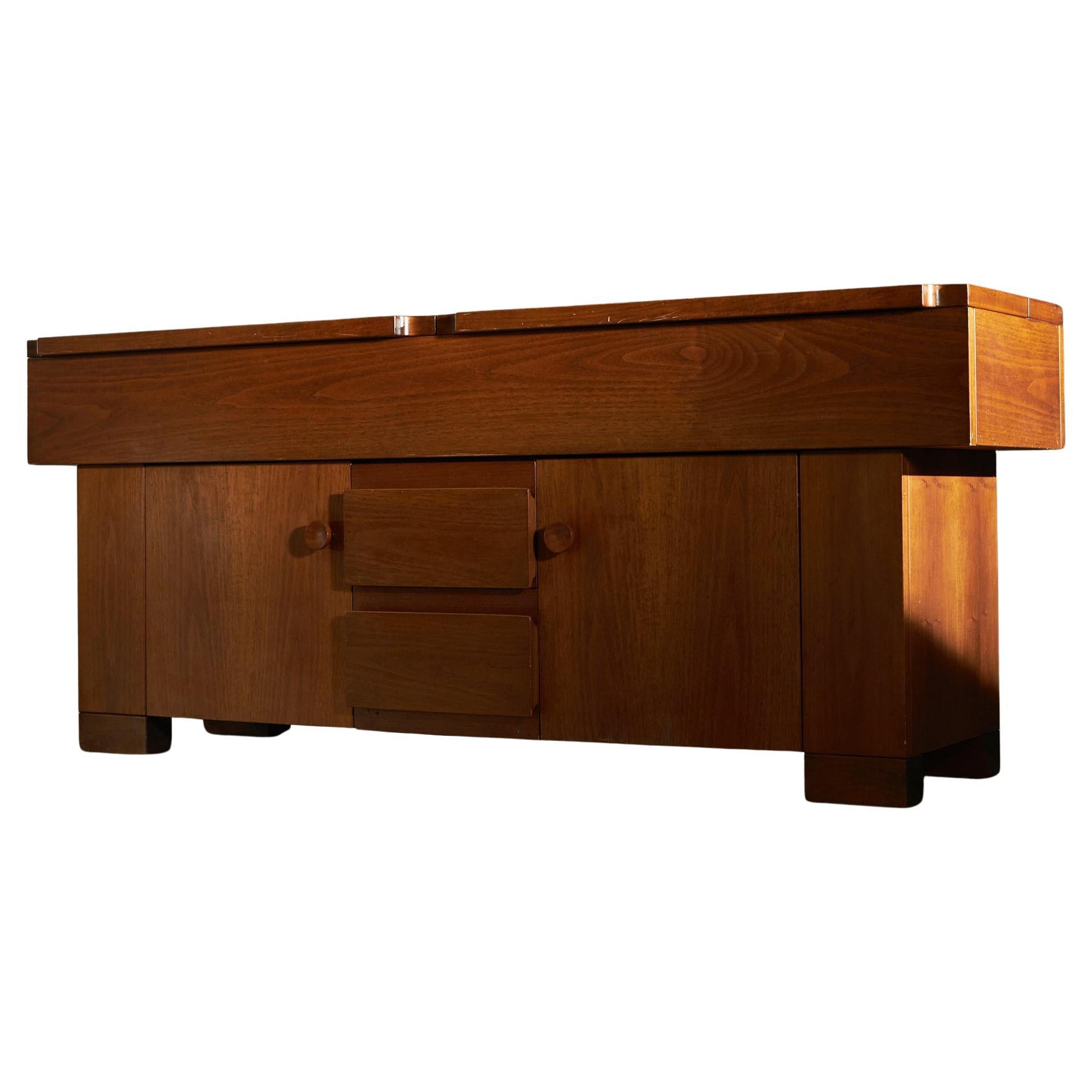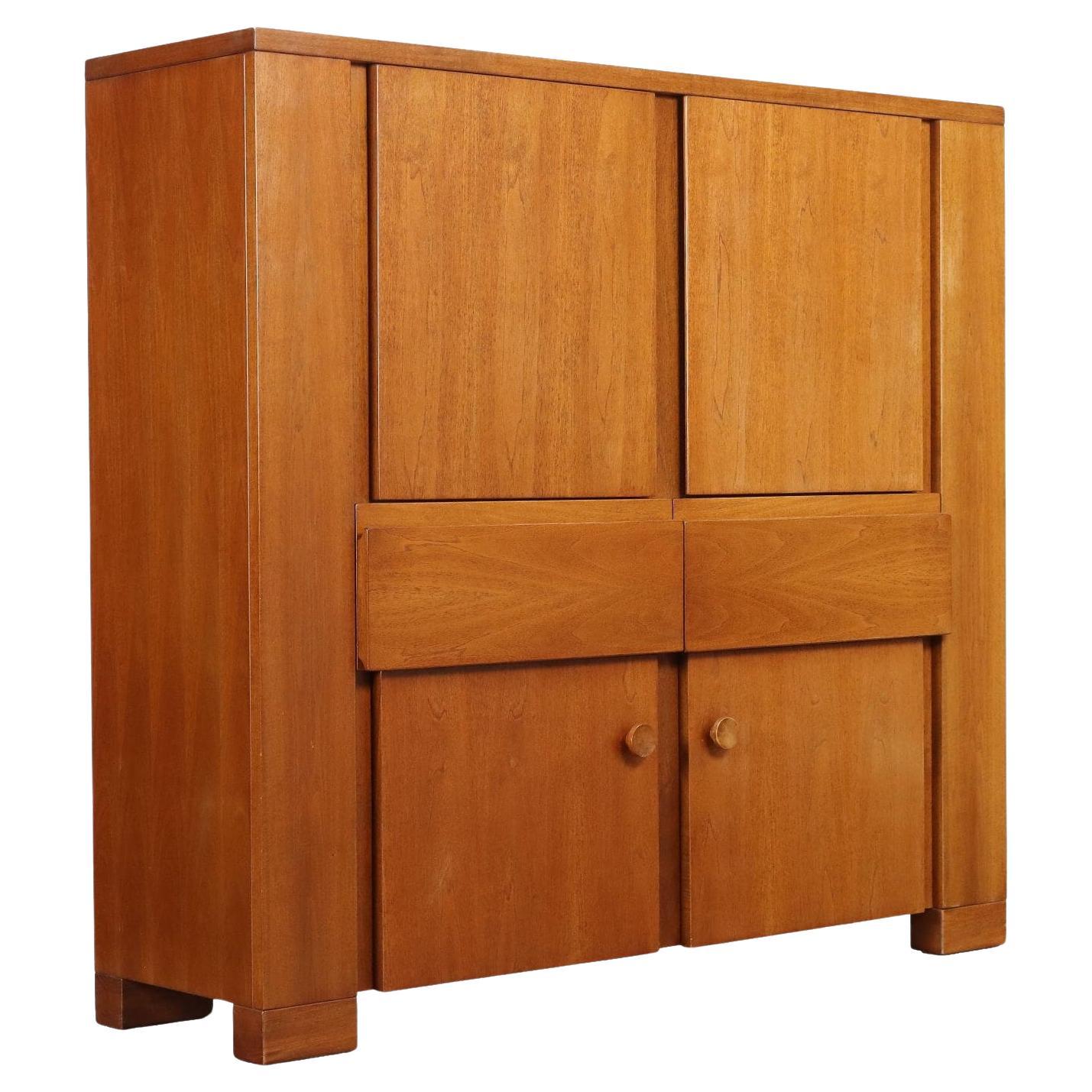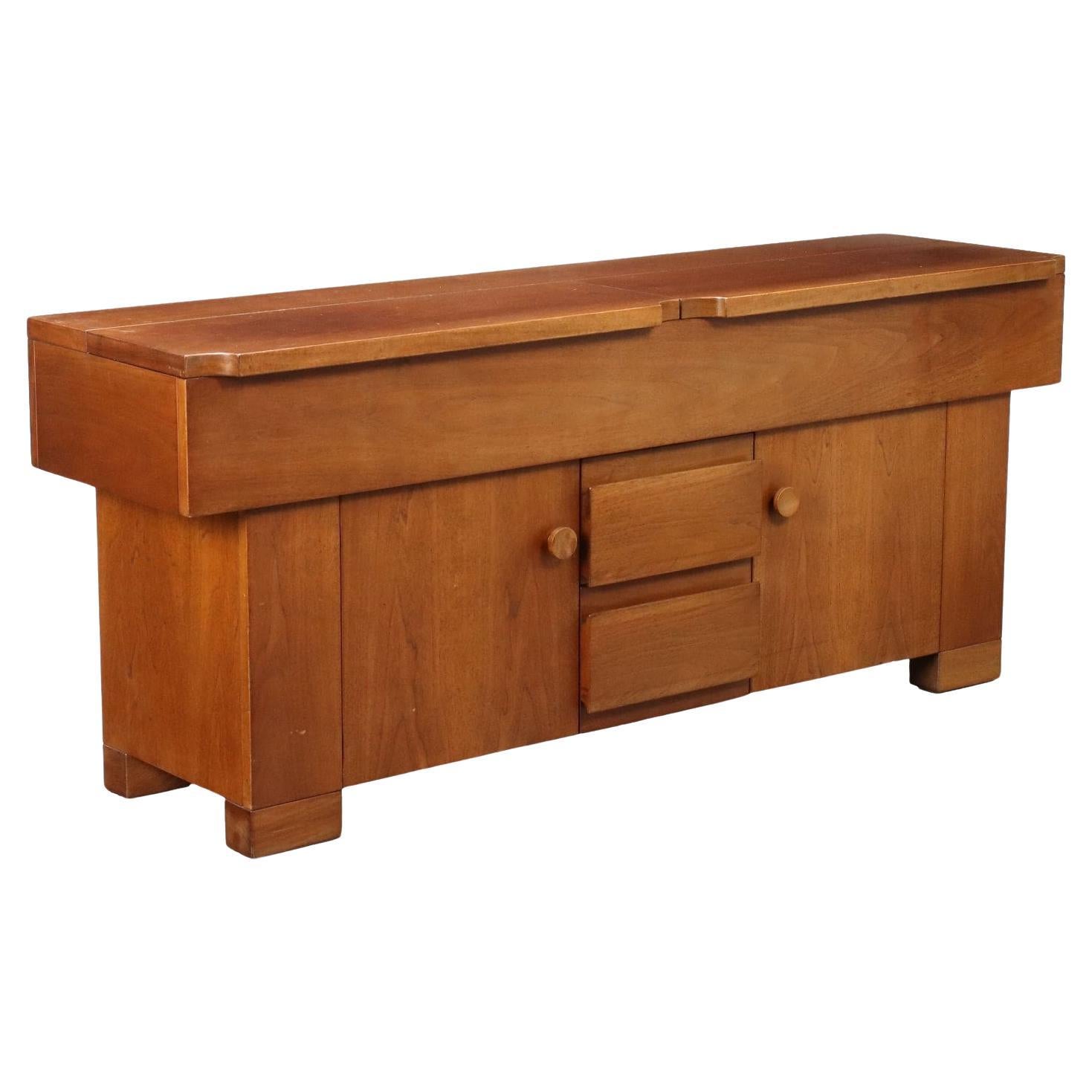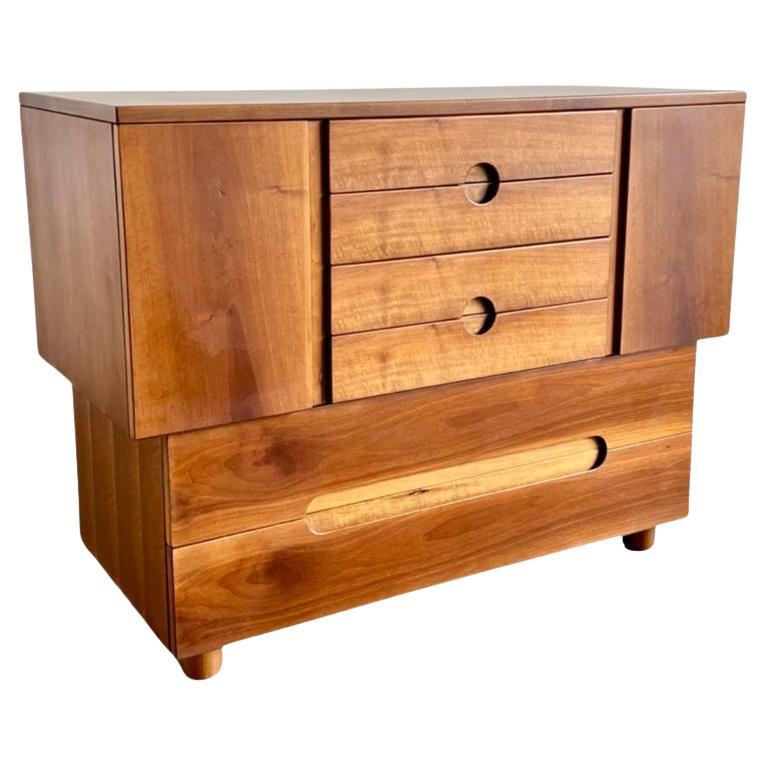Giovanni Michelucci Torbecchia Sideboard in Walnut Wood by Poltronova 1964
About the Item
- Creator:Giovanni Michelucci (Designer),Poltronova (Manufacturer)
- Dimensions:Height: 33.08 in (84 cm)Width: 78.75 in (200 cm)Depth: 20.87 in (53 cm)
- Style:Mid-Century Modern (Of the Period)
- Materials and Techniques:
- Place of Origin:
- Period:
- Date of Manufacture:Late 1960s
- Condition:Wear consistent with age and use.
- Seller Location:Montecatini Terme, IT
- Reference Number:1stDibs: LU5304234145222
Giovanni Michelucci
When discussing Italian architect Giovanni Michelucci, it is difficult to decide which is the more impressive achievement: his more than half-century track record of notable projects, which includes designing and restoring some of Tuscany’s most famous landmarks, or his nearly century-long life. While he is often remembered for passing away just two days before his centennial birthday, in the same breath he is memorialized for his exceptional contributions to Tuscan architecture, including Florence’s Santa Maria Novella Train Station, Palazzo delle Poste and restored rooms inside the legendary Uffizi Gallery.
Michelucci’s practice began in childhood, at his family’s artistic metal workshop. There, he rubbed elbows with many passing artists and architects before pursuing design academically at Florence’s Istituto Superiore di Architettura. Michelucci graduated in 1911 and embarked on a long teaching career. By the early 1920s, he was instructing at the Istituto d’Arte of Rome and later at the Istituto Superiore di Architettura, from 1928 until 1936. He served as dean of the school’s architectural faculty twice during the 1940s and founded the magazine La Nuova Città between the two appointments. He left Florence in 1948 to become a professor at the School of Engineering in Bologna, where he remained until his retirement.
Other significant architectural projects dot Michelucci ‘s career, like the Santa Maria Novella church and church of St. John the Baptist. Often working in collaboration with the Grouppo Tuscano, a collective of young architects, Michelucci beat out more than 100 other bidders on multiple contracts to bring his modernist, rationalist approach to Italy’s architectural landscape.
In his hometown of Pistoia, as well as Fiesole, Michelucci formed the Fondazione Giovanni Michelucci, which undertook social projects targeted at prisons, hospitals and asylums within the cities. He dedicated the rest of his life toward using architecture to address social challenges — a cause the foundation continues to support today.
On 1stDibs, find a collection of Giovanni Michelucci lighting, case pieces and tables.
Poltronova
Poltronova is known for embracing the creativity that opposites can introduce to a space. Its radical modernist furniture and lighting fixtures are simultaneously grounded in classic aesthetics and inspired by what were then new and provocative artistic movements in mid-century Italy, when the company was founded. This tension resulted in unique and extraordinary pieces at the manufacturer, from eccentric, glove-shaped armchairs to striking dining tables that feature a mix of materials and textures.
Italian designer Sergio Cammilli founded Poltronova in Tuscany in 1957. That same year, it won the Compasso d’Oro for the Panchetto chair designed by Luciano Nustrini. Revolutionary Italian architect Ettore Sottsass — a maestro of postmodern design who would later establish the Memphis Group — came on board as an art director in 1958. Poltronova manufactured many of his furniture and ceramic designs. Sottsass’s lighting, seating and other works for Poltronova showcase the designer’s bold experimentation with solid wood, glass, metal and laminate materials.
Other established names in Italian furniture design collaborated with Poltronova’s Sottsass and Cammilli, including Giovanni Michelucci, Gae Aulenti and Angelo Mangiarotti. However, the company truly set itself apart in its collaborations with Superstudio and Archizoom Associati, groups that were part of an irreverent, avant-garde movement in art and design that took shape during the 1960s in Florence, Turin and Milan. Collectives associated with the movement — which would one day be called Italian Radical design — drew on Pop art and minimalism and explored working with unconventional materials to create colorful, quirky and uniquely shaped objects and furnishings. At the time, Poltronova also worked with up-and-coming names in the art world, like painter Max Ernst and sculptor Mario Ceroli.
Poltronova showcased its groundbreaking designs in many exhibitions, such as “La Casa Abitata,” which was held in Florence in 1965. At Milan's Eurodomus trade show in 1970, Poltronova debuted an entire bedroom collection designed by Sottsass — including his sensuous Ultrafragola mirror. The brand’s furnishings were included in a 1972 exhibition at New York’s Museum of Modern Art called "Italy: The New Domestic Landscape," and in 1977, Poltronova again won the Compasso d’Oro for a book called Fare Mobili con Poltronova (Making Furniture with Poltronova).
Poltronova's enduring and acclaimed furniture designs came to be loved far outside Italy. During the 1960s, importer Charles Stendig represented the company and helped introduce it to the American market.
In 2005, Poltronova established the Centro Studi Poltronova to recreate some of the company's iconic furniture. The brand has also recently collaborated with English architect Nigel Coates, who worked with a Poltronova master craftsman in Italy to design a series of limited-edition furniture in 2011, including the Domo chair.
On 1stDibs, find vintage Poltronova tables, seating, storage cabinets and more.
- ShippingRetrieving quote...Ships From: Borgo a Buggiano, Italy
- Return PolicyA return for this item may be initiated within 7 days of delivery.
- Ettore Sottsass Rocchetto Round Side Table in Walnut Wood by Poltronova 1964By Poltronova, Ettore SottsassLocated in Montecatini Terme, ITRocchetto side table realized in lacquered walnut wood with bright orange decorations (under the table top and on the base), it was designed by Ettore Sottsass and manufactured by Po...Category
Vintage 1960s Italian Post-Modern Tables
MaterialsWood, Plastic, Walnut
- Emilio Lancia Large Sideboard in Walnut Wood Italian Manufacture 1930sBy Emilio LanciaLocated in Montecatini Terme, ITA mid-century sideboard with structure in walnut veneer with brass details, the sideboard presents three doors and six inner shelves. Designed by Emilio Lancia, Italian manufacture ...Category
Vintage 1930s Italian Mid-Century Modern Sideboards
MaterialsBrass
- Giotto Stoppino Sheraton Sideboard in Black Lacquered Wood by Acerbis 1970sBy Acerbis, Giotto StoppinoLocated in Montecatini Terme, ITSheraton sideboard in black lacquered ash wood, with a glossy finish, laminated and glass shelves, designed by Giotto Stoppino and produced by Acerbis in 1977 ca. The sideboard pres...Category
Vintage 1970s Italian Mid-Century Modern Sideboards
MaterialsLaminate, Wood, Ash
- Vico Magistretti Samarcanda Sideboard in Black Wood and Skai by Poggi 1970sBy Vico Magistretti, PoggiLocated in Montecatini Terme, ITSamarcanda or CS49 sideboard composed of two modules in black lacquered beech plywood and top in wood covered with black skai. This Samarcanda sideboards presents frontal drawers and doors revealing inner shelves. Designed by Vico Magistretti and produced by Poggi in 1970s Samarcanda is an easily stackable system of drawers and containers that can compose living-room furniture, chests of drawers, tables and desks. It is a system of self-standing drawers made of beech multi-layered plywood lacquered with polyurethane paint in black and white that can be freely stacked and combined. Licterature: R. Dulio, F. Marino, S.A. Poli, Il mondo di Poggi. L'officina del design e delle arti, Electa, Milano 2019, p. 129 Domus 1971, 497 Ludovico Magistretti was born in Milan on 6 October 1920. He went to Parini High School and in autumn 1939 enrolled in the Faculty of Architecture at the Royal Polytechnic in Milan. After 8 September 1943, to avoid being deported to Germany, he left Italy during his military service and moved to Switzerland, where he took some academic courses at the Champ Universitaire Italien in Lausanne, taught at the local university. During his stay in the Swiss city he met Ernesto Nathan Rogers, the founder of the BBPR firm who had taken refuge in Switzerland after racist laws were passed in Italy. This was a key encounter in Magistretti’s intellectual and professional development, since the architect from Trieste turned out to be his maestro. He returned to Milan in 1945, where he graduated in Architecture at the Polytechnic on 2 August. He then immediately began his career working with the architect Paolo Chessa at the firm owned and run by his father, who died prematurely that same year. Here, in his father’s small firm, he spent his entire career in partnership with Franco Montella. During reconstruction operations in Milan from 1949-59, Magistretti designed and constructed about 14 projects for INA-Casa in conjunction with other architects. He was involved with Mario Tedeschi in the joint project for the QT8 neighbourhood, designing houses for veterans from the African campaign and also Santa Maria Nascente Church. In 1946 he participated in the R.I.M.A. exhibition (Italian Assembly for Furniture Exhibitions), held at the Palazzo dell’Arte, designing some small almost self-made pieces of furniture and then, in 1947 and 1948, he took part together with Castiglioni, Zanuso, Gardella, Albini and others in the exhibitions organized by Fede Cheti, a furniture fabric maker, held at her own workshop. The young architect was involved in plenty of activities and came up with lots of new ideas and proposals in the 1950s. Over the following years he also designed a number of other important projects, including the Towers in piazzale Aquileia (1961-64), Bassetti House in Azzate (1960-62), Cassina House in Carimate (1964-65), and the house in via Conservatorio in Milan (1963-66). In 1956 he was one of the founding members of the ADI, Industrial Design Association, and during the same year he was a member of the panel of judges for the Golden Compass Award for the first time. His work as an architect was almost totally focused on the issue of housing and living from the 1960s onwards, as he developed his own extremely expressive idiom, which, even though it was heavily criticised at times, made a real impression on the architectural scene in Lombardy during that period, making him one of its leading figures. This is the context in which he took part in the CIAM Congress (International Modern Architecture Congress) held in Otterlo in the Netherlands in 1959, during which the Italians presented Velasca Tower designed by the BBPR, the Olivetti canteen designed by Ignazio Gardella, Arosio house designed by Vico Magistretti (1956-59), and the houses in Matera designed by Giancarlo De Carli...Category
Vintage 1970s Italian Post-Modern Sideboards
MaterialsFaux Leather, Wood
- Pier Luigi Colli Large Sideboard in Wood with Drawers Italian Manufacturer 1930sBy Pier Luigi ColliLocated in Montecatini Terme, ITLarge sideboard is entirely realized in oak wood, with four drawers on each side (for a total of eight drawers) and a central storage unit. Designed by Pier Luigi Colli Italian Manufacture from 1938 ca. To reconstruct the story of Pier Luigi Colli, we must take a leap back to the 19th century in Turin, a multifaceted city, in some ways controversial due to its austere and sometimes introverted character, but at the core of a creative drive: and if it is primarily known for its automobile industry, there was a time when Turin was at the height of fame also in the field of furniture and embroidery, thanks to the presence of two entrepreneurial realities. On the one hand there was the MIRAM (Italian Hand-Made Embroidery Manufacture) founded by Pietro Colli in 1850, specializing in gobelin fabrics and bandera embroideries. His daughter Teresa traveled between Italy and Paris to discover the latest trends in fabrics and embroidery, while her younger brother, Pier Luigi Colli (1895-1968), the star of this story, joined the company in 1921. Distinguishing himself for his enterprising personality and willing to continue his father's profession, Pier Luigi was known to his contemporaries as "the artist interior designer", and had no doubts about his future: he moved temporarily to Paris, where he attended L'Ecole des Beaux Arts Décoratives. The other great Turin manufacturer to be mentioned is Martinotti, founded in 1931 by Giuseppe Martinotti and supplier of fine furnishings for the Savoy court, pieces which were characterized by a typically 19th century eclectic style, generally made of exotic woods featuring ivory and tortoiseshell inlays: at that time, Martinotti represented the top of internationality, having even participated in the 1875 Philadelphia exhibition! The two brands' fate merged in 1902, a decisive year for Turin which, hosting the International Exhibition of Modern Decorative Art, became the cradle of the spread of the Liberty style in Italy. In the exhibition, Martinotti exhibited an elegant interior, in which all the textile parts, from the curtains to the seat upholstery, was made by Colli. It was in 1926 that Colli (MIRAM) finally acquired Martinotti, founding a laboratory where, from the savoir faire of the two companies, complete pieces of furniture were created and tailor-made for the customer, from the structure to its upholstery. Meanwhile, Pier Luigi Colli was living in Paris, the ideal place to be in 1925, when the International Exhibition of Modern Decorative and Industrial Arts brought him closer to the work of one of his putative fathers, the great French cabinet maker Jacques-Émile Ruhlmann (Paris, 1879 - 1933). Thanks to Paris, Pier Luigi intertwined contacts with the international beau monde, he started to import Lalique glass from France, while the Colli's clientele expanded and special commissions arrived, such as the creation of the Royal Train of the Savoy family made with Fiat, or the lecture hall in the University of Turin. The success of a brand is also measured by its openness to establishing collaborations with the great designers of its time, in the case of Colli resulting in important creative partnerships: from Gio Ponti, who relied on the brand for his Richard Ginori project in Rome, up to Carlo Mollino, who created with Colli the handrails of the RAI (national TV) auditorium and the windows of the Teatro Regio in Turin; also in Turin, the Morbelli architects collaborated with Colli for the furnishings of the RAI skyscraper, and the architects Gabetti Isola for the interiors of the Stock Exchange in Turin. In the 40s and 50s, having opened a branch in Rome, Colli was at the peak of productivity. The embroidery and textile section continued to be one of its strengths, keeping alive the relations with France and its great masters: among the inspirations were the geometric shapes of the fabrics of Ruhlmann's interiors, or the tactile carpets made by designer Mariod Dorn. And so, another Colli trademark become the "textured carpet...Category
Vintage 1930s Italian Mid-Century Modern Sideboards
MaterialsWood, Oak
- Ettore Sottsass T72 Round Table in Wood and Brass by Poltronova 1950sBy Poltronova, Ettore SottsassLocated in Montecatini Terme, ITRound table model T72 in wood, black lacquered metal and brass details, designed by Ettore Sottsass and produced by Poltronova in the late 1950s. The T72 table has a strong base mad...Category
Vintage 1950s Italian Mid-Century Modern Dining Room Tables
MaterialsMetal, Brass
- Torbecchia Sideboard by Giovanni Michelucci for Poltronova, 1964By Giovanni Michelucci, PoltronovaLocated in Budapest, HUTorbecchia sideboard, in solid veneered walnut, with two hinged doors (with internal shelves) and two drawers at the front, and storage under the opening top. The side of the furnitu...Category
Mid-20th Century Italian Mid-Century Modern Sideboards
MaterialsWalnut
- Poltronova Sideboard in the Style of Torbecchia by Giovanni Michelucci, 1970sBy Poltronova, Giovanni MichelucciLocated in Vicenza, ITSideboard made by Poltronova in 1970. The technical office of the brand designed it in the style of the Torbecchia series by Giovanni Michelucci. Made of walnut. Excellent vintage c...Category
Vintage 1970s Italian Mid-Century Modern Credenzas
MaterialsWalnut
- Sideboard 'Torbecchia' by Giovanni Michelucci for Poltronova Anni 60-70By Poltronova, Giovanni MichelucciLocated in Milano, ITSideboard cabinet with hinged doors and exposed drawers, designed by Michelucci in 1964; walnut veneer wood. Good ConditionCategory
Vintage 1960s Italian Mid-Century Modern Credenzas
MaterialsWalnut
- 'Torbecchia' cabinet by Giovanni Michelucci for Poltronova 1960s-70sBy Poltronova, Giovanni MichelucciLocated in Milano, ITSideboard cabinet with hinged doors and exposed drawers, designed by Michelucci in 1964; walnut veneer wood. Good conditions.Category
Vintage 1960s Italian Mid-Century Modern Credenzas
MaterialsNutwood
- Giovanni Michelucci Serena Chest of Drawers for Poltronova, 1955By Poltronova, Giovanni MichelucciLocated in Byron Bay, NSWGorgeous and rare "Serena "chest of drawers mod. Serena in walnut wood, designed by Giovanni Michelucci for Poltronova, 1955, Italy. Signed piece.Category
Vintage 1950s Italian Mid-Century Modern Commodes and Chests of Drawers
MaterialsWalnut
- Italian Modern Teak and Metal Sideboard with Sliding Doors by Poltronova, 1970sBy PoltronovaLocated in MIlano, ITItalian modern teak and metal small sideboard with sliding doors by Poltronova, 1970s Sideboard or sideboard, small and rare dimensions, in teak with sliding doors. Round metal hand...Category
Vintage 1970s Italian Modern Sideboards
MaterialsMetal, Steel







